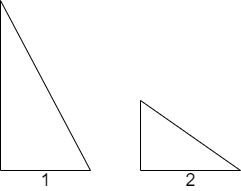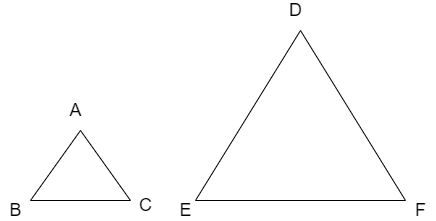
What are similar triangles and their properties?
Answer
556.2k+ views
Hint: We explain the similar triangles using the definition of similar figures.
The similar figures are the figures having the same shape but of different sizes of any orientations.
By using this definition of similar figures we define the similar triangles and their properties of angles and sides.
We use the theorem that there are mainly two properties of the similar triangles
(1) All the corresponding angles of two triangles are equal.
(2) The ratios of corresponding sides are equal.
Complete step by step answer:
Let us define the similar triangles first
We know that similar figures are the figures having the same shape but of different sizes of any orientations.
So, we can say that if the similar figures in the above statement are triangles then we can say that the two figures are similar triangles.
So, we can define the similar triangles as
“The two triangles having the same shape but different size having any orientation are said to be similar triangles.”
Let us take 2 to 3 examples of similar triangles as follows
(1)

(2)

(3)

Here, all the examples are examples of similar triangles.
Now, let us give the properties of similar triangles.
We know that there are mainly two properties of the similar triangles
(1) All the corresponding angles of two triangles are equal
(2) The ratios of corresponding sides are equal
Let us assume that there are two similar triangles as follows

Here, let us assume that \[\Delta ABC\sim \Delta DEF\]
Now, by applying the first property we get
\[\begin{align}
& \Rightarrow \angle A=\angle D \\
& \Rightarrow \angle B=\angle E \\
& \Rightarrow \angle C=\angle F \\
\end{align}\]
Similarly, by applying the second property then we get
\[\Rightarrow \dfrac{AB}{DE}=\dfrac{BC}{EF}=\dfrac{CA}{FD}\]
Therefore, we can conclude that there are two properties of similar triangles as stated above.
Note: Students may make mistakes in applying the properties of similar triangles.
We have the first property that is
(1) All the corresponding angles are equal
Here, the term corresponding is very important.
While applying the first property to similar triangles \[\Delta ABC\sim \Delta DEF\] we get
\[\begin{align}
& \Rightarrow \angle A=\angle D \\
& \Rightarrow \angle B=\angle E \\
& \Rightarrow \angle C=\angle F \\
\end{align}\]
Bu students may do mistake and take the equal angles other than these as
\[\begin{align}
& \Rightarrow \angle A=\angle E \\
& \Rightarrow \angle B=\angle F \\
& \Rightarrow \angle C=\angle D \\
\end{align}\]
This is wrong because the term corresponding indicates that the vertex \['A'\] corresponds to vertex \['D'\] and similarly the vertices \[B,C\] corresponds to vertices \[E,F\] so that the angles at those vertices must be equal.
The similar figures are the figures having the same shape but of different sizes of any orientations.
By using this definition of similar figures we define the similar triangles and their properties of angles and sides.
We use the theorem that there are mainly two properties of the similar triangles
(1) All the corresponding angles of two triangles are equal.
(2) The ratios of corresponding sides are equal.
Complete step by step answer:
Let us define the similar triangles first
We know that similar figures are the figures having the same shape but of different sizes of any orientations.
So, we can say that if the similar figures in the above statement are triangles then we can say that the two figures are similar triangles.
So, we can define the similar triangles as
“The two triangles having the same shape but different size having any orientation are said to be similar triangles.”
Let us take 2 to 3 examples of similar triangles as follows
(1)

(2)

(3)

Here, all the examples are examples of similar triangles.
Now, let us give the properties of similar triangles.
We know that there are mainly two properties of the similar triangles
(1) All the corresponding angles of two triangles are equal
(2) The ratios of corresponding sides are equal
Let us assume that there are two similar triangles as follows

Here, let us assume that \[\Delta ABC\sim \Delta DEF\]
Now, by applying the first property we get
\[\begin{align}
& \Rightarrow \angle A=\angle D \\
& \Rightarrow \angle B=\angle E \\
& \Rightarrow \angle C=\angle F \\
\end{align}\]
Similarly, by applying the second property then we get
\[\Rightarrow \dfrac{AB}{DE}=\dfrac{BC}{EF}=\dfrac{CA}{FD}\]
Therefore, we can conclude that there are two properties of similar triangles as stated above.
Note: Students may make mistakes in applying the properties of similar triangles.
We have the first property that is
(1) All the corresponding angles are equal
Here, the term corresponding is very important.
While applying the first property to similar triangles \[\Delta ABC\sim \Delta DEF\] we get
\[\begin{align}
& \Rightarrow \angle A=\angle D \\
& \Rightarrow \angle B=\angle E \\
& \Rightarrow \angle C=\angle F \\
\end{align}\]
Bu students may do mistake and take the equal angles other than these as
\[\begin{align}
& \Rightarrow \angle A=\angle E \\
& \Rightarrow \angle B=\angle F \\
& \Rightarrow \angle C=\angle D \\
\end{align}\]
This is wrong because the term corresponding indicates that the vertex \['A'\] corresponds to vertex \['D'\] and similarly the vertices \[B,C\] corresponds to vertices \[E,F\] so that the angles at those vertices must be equal.
Recently Updated Pages
Two men on either side of the cliff 90m height observe class 10 maths CBSE

What happens to glucose which enters nephron along class 10 biology CBSE

Cutting of the Chinese melon means A The business and class 10 social science CBSE

Write a dialogue with at least ten utterances between class 10 english CBSE

Show an aquatic food chain using the following organisms class 10 biology CBSE

A circle is inscribed in an equilateral triangle and class 10 maths CBSE

Trending doubts
Why is there a time difference of about 5 hours between class 10 social science CBSE

Write a letter to the principal requesting him to grant class 10 english CBSE

What is the median of the first 10 natural numbers class 10 maths CBSE

The Equation xxx + 2 is Satisfied when x is Equal to Class 10 Maths

Which of the following does not have a fundamental class 10 physics CBSE

State and prove converse of BPT Basic Proportionality class 10 maths CBSE




